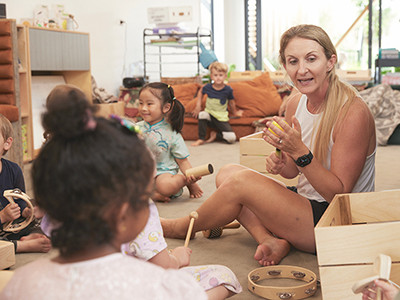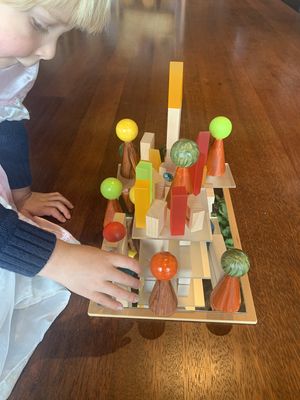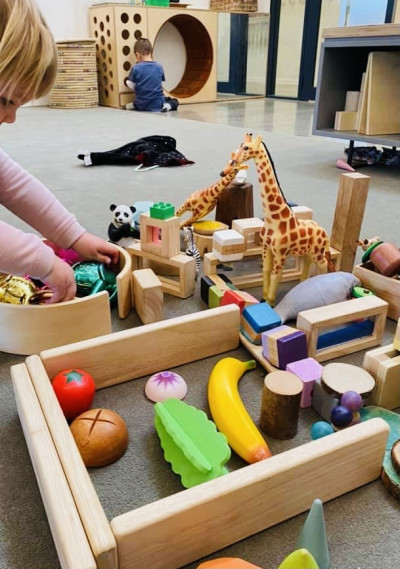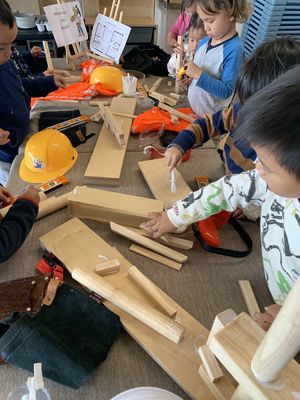Exert from Inspired to Build, Unlocking the Potential of Block Play by Maureen Woodhams, edited by Michelle Pratt
Almost anything we may want children to learn – physical skills, language development, social relationships, maths and science concepts, and many positive learning dispositions – can all be learnt through block play.
“The creative experiences in construction are in terms of design, balance, order, and rhythm; these are essentials in creative expression. The accurate fitting and placing needed is a necessary manipulative experience if the building is to be successful and satisfying, and it is at the point that judgement, reasoning and imagination carry experience into the intellectual and creative spheres” - Gwen Somerset

Multi-unit blocks are plain, wooden blocks that can be freely assembled in any way. Unlike some block and construction systems, they do not have bumps or indents which limit how they can fit together.
Multi-unit blocks were initially designed by innovative educator Caroline Pratt in the early 1900’s and are similar to the blocks used by Friedrich Froebel in his Kindergartens. They have revolutionised early childhood education and are still used in most classrooms today.
Multi-unit blocks are made of unpainted wood, based on a unit block twice as long as it is wide and twice as wide as it is thick (approximately 130mm long x 65mm wide x 32.5mm thick or 51in long x 25.5in wide x 12.75in thick). Other sizes and shapes are exact multiples and fractions of the unit block. This means that when the blocks are combined, they fit together to support the development of many mathematical concepts.
The exact dimensions of the unit block are less critical than the need for all the blocks to be in exact proportion to each other. When purchasing a new metric set, any old blocks must be separated and reserved for another use (e.g., outdoors).
The wooden blocks are left unpainted to allow the natural beauty of the wood grain to remain apparent. It also means that when a child selects blocks for building it is on the basis of their size and shape, not by colour. As the blocks are plain they can also be used to represent anything that the child can imagine. Additional accessories, loose parts, and natural resources, including small blocks, may be coloured.
Multi-unit block dimensions
Using the correct names for the various block sizes and shapes introduces children to language commonly used with mathematical concepts.
There is not always complete agreement on the names for the various sizes and shapes but the following descriptions are based on the historical understanding of the writer and seem to be the most commonly used terms. In these descriptions, ‘X’ represents the width of the unit block (about 65mm or 26in) and the ratio is Length : Width : Thickness.
Core Unit Blocks
 Unit Block - 2X : X : 1/2X. A brick shape block twice as long as it is wide and half as thick. This is the core block that the measurements are derived.
Unit Block - 2X : X : 1/2X. A brick shape block twice as long as it is wide and half as thick. This is the core block that the measurements are derived.
Double Unit Block - 4X : X : 1/2X. Twice as long as the Unit Block, with the same width and thickness.
Quadruple Unit Block - 8X : X : 1/2X. Four times as long as the Unit Block, with the same width and thickness.
Half Unit - X : X : 1/2X. A square-based prism half the length of the Unit block, with the same width and thickness.
Additional Unit Blocks

Pillar - 2X : 1/2X : 1/2X. A square-based prism half the width of the Unit Block, but the same length and thickness.
Half-Pillar - X : 1/2X : 1/2X. A square-based prism half the width and length of the Unit Block with the same thickness.
Column - 2X : 1/2X dia. A circular prism, or cylinder, with a diameter equal to the Pillar thickness and the same length.
Half-Column - X : 1/2X dia. A circular prism, or cylinder, with a diameter equal to the Pillar thickness but half the length.
Half-Unit Triangle - A right-angle equilateral triangle made by ‘cutting’ the Half-Unit Square on a diagonal of the square face.
Unit-Triangle - A right-angle triangle made by ‘cutting’ the Unit Block on a diagonal of its largest face.
Unit Ramp - Made by cutting the Unit Block in half on the diagonal of its long side face.
Roman Arch - A Unit Block with Half-Circle into the long edge.
Half-Circle - X : X dia : 1/2X. A Half-Circle cut from Roman Arch or Half-Circle Curve.
Half-Circle Curve - 2X : X dia : 1/2X with a Half-Circle cut of X : X dia : 1/2X. A Half-Circle the same width and thickness of the Unit Block, based on an outside diameter of 2X with a Half-Circle neatly fitting inside the curve.
Quarter-Circle - 1/2X : X dia : 1/2X. A Half-Circle ‘cut’ in half to make a quarter circle.
Quarter-Circle Curve - X : X dia : 1/2X. Half-Circle Circle ‘cut’ in half to create a quarter-circle.
Gothic Arch - A Unit Block with a Buttress cut into the long edge.
Buttress - Half-Pillar with a Quarter-Circle stacked together.
Caring for your blocks
A set of multi-unit blocks is known to last for decades. Wood’s natural antibacterial properties mean little care and maintenance are required, and harsh chemicals are unnecessary for cleaning.
Shelves should be regularly dusted and wiped down, including all the blocks.
To clean the unit blocks, simply wipe the surface with a damp cloth. The solution used could be warm water mixed with eco-friendly dish soap (one part soap to four parts water) or a natural disinfectant (one part vinegar to two parts water). Make sure that any soap residue is removed from the surface with a clean damp cloth. Any marked surfaces can be lightly scrubbed and left to air dry or dry with a cloth.
Do not immerse, soak, or put wooden resources in the dishwasher. To avoid fading and cracking, the blocks must be dried thoroughly, away from direct sunlight. A slightly rough surface or a block that starts to split or crack can be lightly sanded with fine-gauge paper and re-oiled.
Oiling your blocks once a year is not essential but will extend their life, preventing them from drying out and cracking or splitting. Wipe with a lightly oiled cloth (e.g., soya bean oil), stack so air can circulate between the blocks, and wipe with a dry cloth as they are put back on the shelf. Ensure that any oils or polishes used are non-toxic and safe for children.
Purchasing Unit Blocks
Guidecraft Unit Block sets are the perfect base for your Block Play.
56 Piece Set includes 16x Unit Blocks, 6x Half-Unit Blocks, 4x Double-Unit Blocks, 4x Unit Triangles, 6x Half-Unit Triangles, 4x Columns, 2x Half-Columns, 6x Pillars, 2x Half-Pillars, 2x Half Circles, 2x Roman Arches, and 2x Roof Boards.
84 Piece Set includes 24x Unit Blocks, 8x Half-Unit Blocks, 4x Double-Unit Blocks, 6x Unit Triangles, 8x Half-Unit Triangles, 6x Columns, 4x Half-Columns, 8x Pillars, 4x Half-Pillars, 4x Half Circles, 4x Roman Arches, 2x Roof Boards, and 2x Floor Boards
135 Piece Set includes 32x Unit Blocks, 16x Half-Unit Blocks, 4x Double-Unit Blocks, 2x Quadruple-Unit Blocks, 8x Ramps, 8x Unit Triangles, 6x Half-Unit Triangles, 6x Columns, 6x Half-Columns, 6x Pillars, 6x Half-Pillars, 4x Half-Circles, 2x Quarter-Circles, 2x Half-Circle Curves, 2x Quarter-Circle Curves, 6x Roman Arches, 4x Gothic Arches, 2x Buttresses, 4x Roof Boards, 2x Floor Boards, and 1x Intersection
218 Piece Set includes 48x Unit Blocks, 28x Half-Unit Blocks, 8x Double-Unit Blocks, 4x Quadruple-Unit Blocks, 12x Ramps, 10x Unit Triangles, 10x Half-Unit Triangles, 8x Columns, 10x Half-Columns, 10x Pillars, 10x Half-Pillars, 4x Half-Circles, 4x Quarter-Circles, 4x Half-Circle Curves, 4x Quarter-Circle Curves, 10x Roman Arches, 6x Gothic Arches, 4x Buttresses, 6x Roof Boards, 4x Floor Boards, 2x Intersection, and 2x Side Roads.
Enspirement has curated a range of resources to complement the Unit Blocks and extend children’s learning opportunities. Start creating your wishlists today.


 Michelle Pratt
Michelle Pratt
